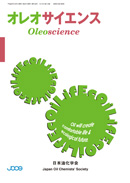
- |<
- <
- 1
- >
- >|
-
Tomohiko OKADA2014Volume 14Issue 5 Pages 189-196
Published: 2014
Released on J-STAGE: February 01, 2017
JOURNAL FREE ACCESSIntercalation of organic cations and molecules into smectite group of layered clay minerals has been overviewed. Interlayer space of the smectites plays an important role in assembling the cationic species to produce unique inorganic-organic hybrid materials. These are useful for various applications as adsorbents for hazardous nonionic organic compounds, dye-supports, and controlled release. The structure-property-performance relationship of the hybrids has been introduced in this review.
View full abstractDownload PDF (1296K) -
Shin’ichi ISHIMARU, Kana SATO2014Volume 14Issue 5 Pages 197-203
Published: 2014
Released on J-STAGE: February 01, 2017
JOURNAL FREE ACCESSIn this paper we summarized intercalation behavior of N-isopropylacrylamide (NIPA) monomer into cation-exchanged clays and characterization of photosynthesized clay-poly(NIPA) nanocomposites with several clay minerals. The monomer intercalation was possible by both solid-liquid and solid-solid reactions with Na-saponite, Na-montmorillonite, Na-hectorite and various cation-exchanged saponites. Hydrogels of clay-poly(NIPA) (clay: saponite, hectorite and fluorohectorite) were formed by photopolymerization. The appearance of the obtained hydrogels for the composite of saponite was translucent and relatively stiff, whereas that for fluorohectorite was highly transparent and soft. DSC measurements showed an endothermic anomaly at the volume phase transition in each hydrogel upon increasing temperature. The transition heat decreased with increasing clay content. Swelling behaviors were significantly different between the composites of saponite and fluorohectorite. The amounts of absorbed water in the fluorohectorite-composites were 2-4 times greater than that in the saponite- and hectorite-composites at the same clay content. The equilibrium water content in the hydrogel decreased with increasing amount of saponite and hectorite, however, almost no correlation between the clay and water contents in the composite of fluorohectorite was observed.
View full abstractDownload PDF (873K) -
Makoto MINASE2014Volume 14Issue 5 Pages 205-211
Published: 2014
Released on J-STAGE: February 01, 2017
JOURNAL FREE ACCESSThe organophilic bentonites are organic denaturing clays of montmorillonite of which surface layer is reacted with a quaternary ammonium ion. These types of bentonites, which swell and delaminate in organic solvents, are widely used in many industrial fields. Rheology control like viscosity modifier and antisettling agent are the main usage of this material. Recently the material has also been studied as a functional filler for resins. In this paper, we review the property of organophilic bentonites, their characteristics as a rheology control agent, and disperse-processing methods. We also introduce application to a functional filler for nano-composites as one of a new usage of this material.
View full abstractDownload PDF (1203K) -
Takuya FUJIMURA, Tetsuya SHIMADA, Shinsuke TAKAGI2014Volume 14Issue 5 Pages 213-218
Published: 2014
Released on J-STAGE: February 01, 2017
JOURNAL FREE ACCESSClay minerals are commonly used industrial materials. On the other hand, they are unique and attractive materials form the viewpoint of science, because they have very flat surface and densityvariable anionic charges. Clay minerals-functional organic dye complexes are suitable model for the investigations on the interaction between inorganic surface and organic guest molecules, which are important subject in the field of surface sciences. Recently, we found out that the adsorption density and molecular orientation of porphyrin dye on the clay surface can be controlled. In this paper, the detailed adsorption behavior of porphyrin dyes on the clay surface is described.
View full abstractDownload PDF (1727K)
- |<
- <
- 1
- >
- >|